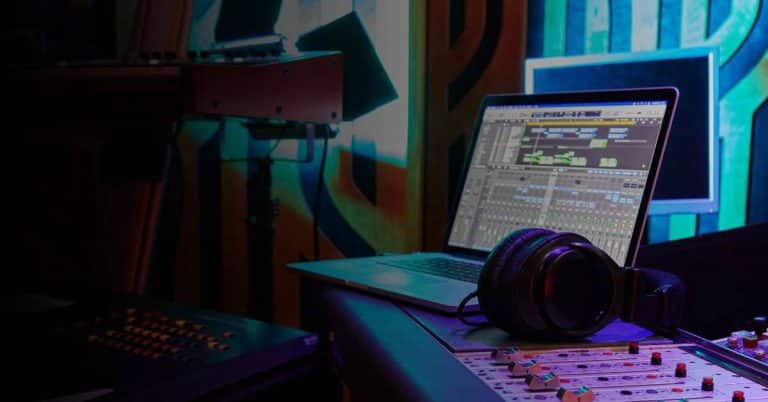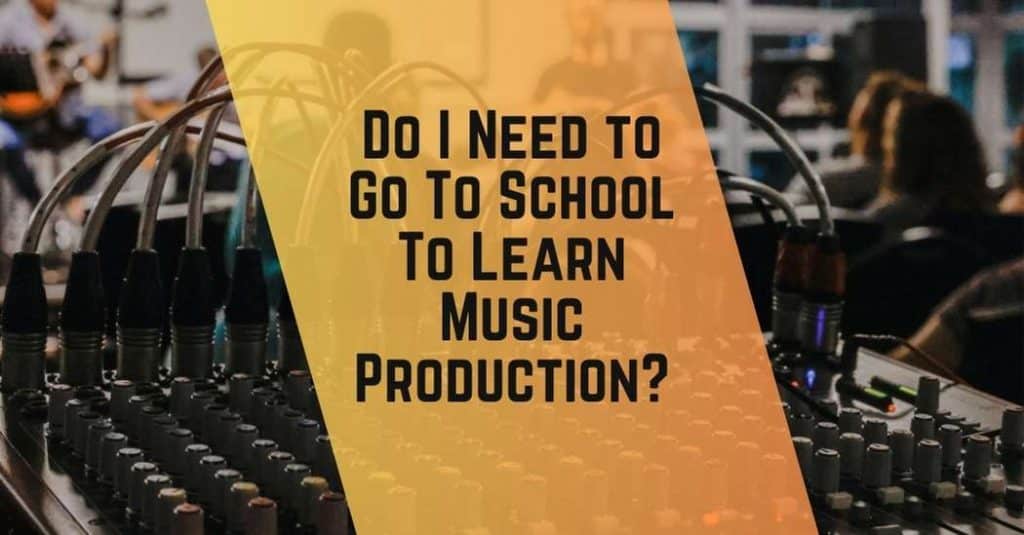This page contains affiliate links, which means I may receive a commission if you purchase through links on my site, at no additional cost to you. Find out more here: affiliate disclosure.
Welcome to an exciting new hobby! Learning electronic music production is a highly rewarding skill that will provide you with lots of joy… & probably frustration. When you first start learning how to make electronic music, it can be a little overwhelming; it can be unclear where to start and what’s important to learn. This guide will help you navigate that. I’ve organized the guide into production topics you need to know and provided you with an entry-level foundation to help you start making electronic music. The guide is broken down into sections that you can digest at your own pace. Feel free to jump around the guide to parts that suit you. You can navigate via the table of contents below (its collapsable).
What is Electronic Music Production?
Ok, so what do we actually mean when we say “electronic music production”? The concept of electronic music is a fairly wide category; for the purposes of this guide, I’m defining electronic music as music composed solely using electronic & digital instruments or a combination of electronic and acoustic sounds.
In this guide we will be learning to make electronic music by creating and manipulating sound using synthesizers, hardware, computers, drum machines, samples and effects units.
Related: The Best Electronic Music Production Books
How do I start studying music production?
There are many approaches you can take when learning how to make electronic music; it depends on your aims and how dedicated and disciplined you want to be. It will help to define a goal – decide your aim for learning electronic music production. Consider whether you want to do this as a hobby, play shows, release music, or make a career out of it. All these goals require you to learn and practice production, so how much time you’re willing to put aside to do that?
If you’re happy to learn electronic music production slowly, try the DIY approach…
DIY Approach
If you are just a keen hobbyist, then you could take a chilled-out DIY approach where you learn when it suits you, watch free production tutorials on YouTube and compile info from music production blogs (like mine ;). You could occasionally take the odd paid course via well-known brands such as PML & Loopmasters on topics that interest you. (This is particularly useful to learn a new production technique for a particular genre.) Or buy a music production book to dip into every now and again
If you are not too serious about progressing as a producer, this approach will suit you nicely.
The downside to this style of learning is that you are taking an unstructured approach, and it will take a very long time to improve your music production skills.
When I wrote about how long it takes to learn music production I discovered that creating deliberate practice is the best way to learn a new skill.

Deliberate practice
The other approach is to take a much more structured, formalized approach to your learning. This means that you are dedicated much more time to education and practice. This may be in a formal education setting such as an electronic music production course or purposefully designing a learning path for yourself. A good place to start will be this guide, as it lays out the topics you need to learn about electronic music production. You can use this as your path.
When researching how long it takes to learn music production, I discovered the 20-hour rule from Josh Kaufman. In his book Josh states that it takes you 20 hours to get good at a new skill. This is 20 hours of deliberate practice.
Josh advises the following methods to ensure we are doing the right type of practice:
- Break down the skill you want to learn – which is why you are using the guide here.
- Learn Enough to Self-Correct – enroll in a production course, use a book or tutor to guide your learning.
- Remove barriers – Allow yourself to feel frustrated and make shit music! Remove any barriers of shame or having to be ‘good enough’. You’re learning – be kind to yourself.
- Practice at least 20 hours -Commit to doing 20+ hrs of deliberate practice. If you start with just 40 mins practice for 30 days you will have done your first 20hrs 🙂
Start practicing 40 mins a day & you’ll have done 20+hrs practice in 30 days.
Related: The Best Electronic Music Production Courses
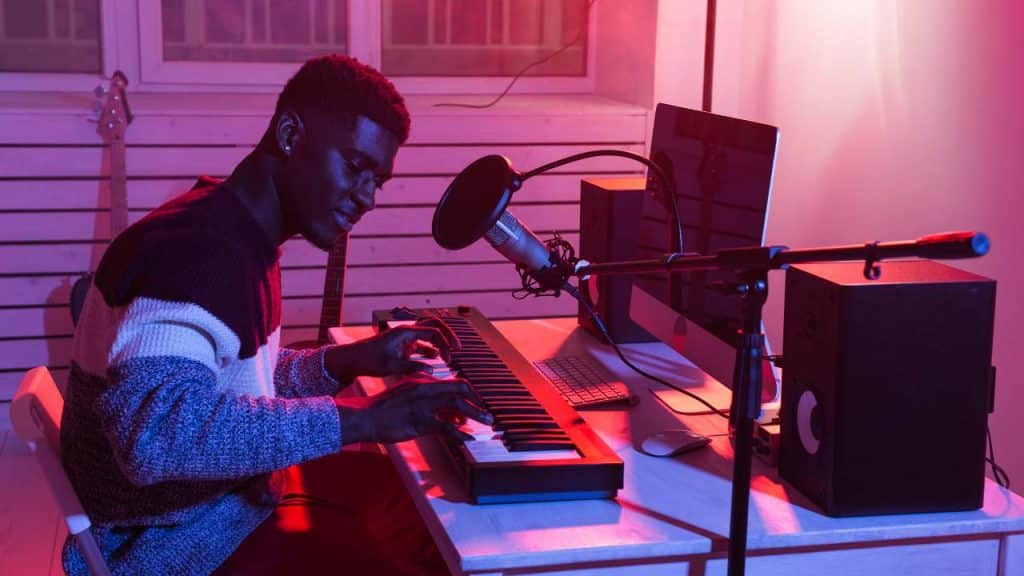
Setting up your studio – Equipment
Sorting out your music production setup can take time. As a newbie, you can spend a lot of time working out which gear is best for you. To try and help cut down some of the time it takes to get set up, here’s a brief overview of the equipment used in electronic music production and what you will need to start producing electronic music.
- Computer
- DAW
- Headphones
- MIDI Controller
- Speakers
- MIDI Keyboard
- Microphones
- Hardware Instruments
- Plugins
Don’t worry – You don’t need all this gear to make music!
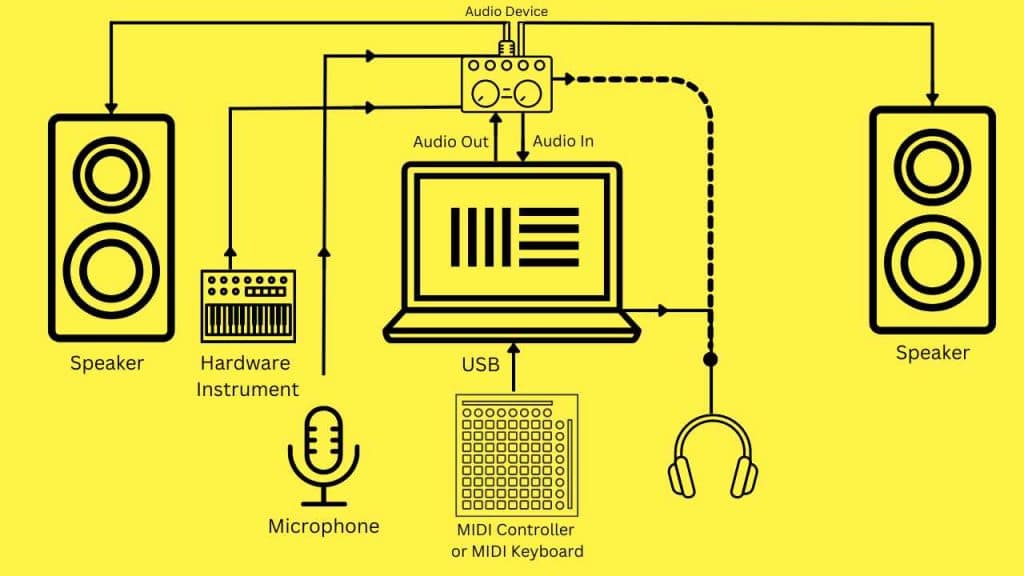
Minimum Required Setup
You can start making electronic music with a laptop and headphones; your setup doesn’t need to be fancy.
In fact, when you start producing music, a simple setup creates fewer distractions and helps you focus your learning. You can slowly add more to your setup as your production skills progress.
To start with, get a basic setup and start learning about additional gear available to you. Keep it simple to start with and add more complexity as you go.
I’ve suggested two setups below:
- Computer or Laptop + headphones (minimum required setup)
- Computer or Laptop + Headphones + Audio Device + Speakers + (then add as needed: MIDI Keyboard, Midi controllers, Microphones, Hardware)
Setup 2 allows you to add more gear as you go. I advise getting an audio device and speakers before you invest in other gear. You can see how this setup would look in fig 1.1.

Learning a DAW
Most music producers use a digital audio workstation (DAW) to produce music on their computer. Learning a DAW will be one of the main skills you’ll need to learn. It takes time to become an expert with a DAW. However, you can become competent with one quite quickly!
It can be time-consuming trying to wade through all the ‘which DAW is best’ arguments. Basically, if you like a DAW and can find good education on it, then go for it.
I recommend Ableton for electronic music production and Pro Tools for sound engineering and recording bands. Protools is most often used in professional recording studios and excels at recording and mixing. Ableton is amazing and an industry standard for electronic music production. It’s worth investing the time to learn it – you will also be able to use it to perform live and DJ with in the future.
Another benefit of learning Ableton is that there is a massive user community, a ton of content on YouTube, and in-person Ableton User Groups (in most cities) that you can join. Having access to a good network of professionals and peers can help reduce the learning curve.
Of course, Ableton isn’t for everybody, other DAWs are available! You could consider:
- Fruity Loops
- Logic
- Reaper
If you want to learn Ableton faster – check out these courses to help teach you the basics.

Music Production Computer
A solid desktop or laptop will help you make electronic music more than any other piece of gear. It’s the best bit of studio gear for music producers. There is so much you can do with a computer, it will host your DAW, VST plugins and record, mix, and master your music for you. You could arguably make a full album with one.
You can use either a Mac or PC for Music production. It’s really up to you and your budget. If you’re investing in a desktop or laptop, ensure that it will meet Ableton requirements (or your DAW of choice), and you are good to go. You can read more about laptops for Ableton live here.
When choosing a music production computer a good rule of thumb is to prioritise RAM and processor power. I would advise getting 8GB RAM minimum, ideally 16GB RAM. With an SSD for running your DAW and audio files on. Additional storage for your computer and files can be on a SATA drive.
That said, if you’re just starting to make electronic music – don’t obsess too much over computer specs. You’ll be able to make music on a computer if it meets Ableton’s minimum requirements.
I’m currently running a second hand M1 Macbook Air for live shows, DJing and on the go music production- it works perfectly fine.
This article will help you if you’re looking for a Laptop for Ableton Live.

Headphones
Get a decent pair of headphones to monitor your music. You want to aim to buy a pair that is as ‘neutral’ as possible. This means the headphones won’t ‘colour’ your music, giving you an accurate reproduction of your sound. This is needed so that you can hear any issues in your music and adjust accordingly. As a good starter headphone, i’d recommend the Bayer Dynamic DT 770 Pro.
You can make music solely on headphones and a computer. Eventually, though, you’ll want to progress to getting yourself a decent pair of speakers (monitors).
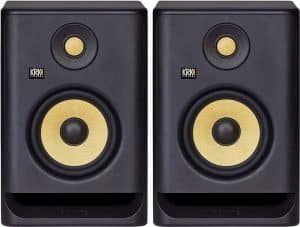
Speakers
After a while, using just headphones won’t cut it. You are going to want to hear your music on speakers. Having a decent pair of monitors is crucial for making electronic music as it will let you reference your mix much more accurately.
Similar to picking a pair of headphones, you want to select a pair of studio monitors that provide an accurate and neutral representation of your music. You do not want them to colour the sound, giving you a false impression of what your music will sound like on other sound systems.
A good starter pair of beginner studio monitors would be the KRK RP5 G4.
Microphones
If you want to record external sounds such as vocals, instruments, or field recordings, you’re going to need a microphone. There are a lot of options out there to choose from, which can be overwhelming. There are microphones best suited to vocal recordings, field recordings or for use with drums – so using or buying a mic will depend on the type of recordings you want to make. If you’re keen to record lots of different sound material, a good all-round microphone would be the Shure SM57.
To use a microphone, you will need a way to get the signal into your recording device. If you have a computer and an audio device, you will be good to go. The audio device will send the microphone input to your DAW – where you can record it.
Additional Paths
If you want to improve as a music producer, you’ll want to learn various recording techniques.
- Learn about different Microphone types – Condenser, Ribbon, Dynamic.
- Stereo Recording Techniques.
- Recording Live Music.

Audio Device
To get the audio out of your computer, you’re going to need an audio device. An audio interface routes the audio out of your DAW to your speakers and headphones. You can also use the audio interface as an input to record audio. Most budget audio interfaces connect by USB and allow 2 x 1/4″ inputs and 2 x 1/4″ outputs. If you spend a little bit more, you can get XLR inputs too, which will allow you to insert and record a microphone. A solid budget audio interface is the Focusrite 2i2 – connected by USB, 2 inputs & outputs, and 2 x quality mic inputs.
You can find audio interfaces with more ins and outs and with higher quality preamps (for better quality microphone recordings). Initially, I would start with a budget model and spend the extra cash when you know what your production needs are.
If you want to read more about audio devices check out the Best Audio Devices for Ableton Live.
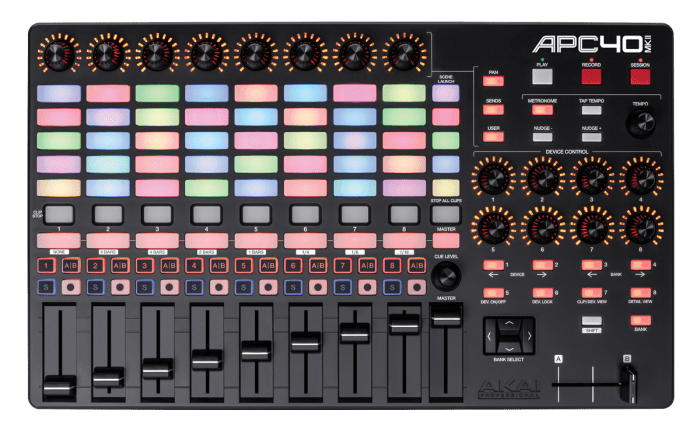
MIDI controller
A MIDI controller is a device you plug into your setup to provide you with a controller over certain parameters (either in a DAW or piece of Hardware). A lot of music producers use MIDI controllers to give them hands-on control over their DAW & Hardware.
You can get small, inexpensive MIDI controllers that help control a few functions such as faders, to much larger controllers that control all of your DAW (such as the Ableton Push).
The right MIDI controller for you really depends on your workflow and what you would find useful in the studio. If you’ve just started learning how to make electronic music, you may not know what kind of MIDI controller you need yet – that’s ok. As you progress with your productions, you will find a desire emerges to do certain production tasks a little differently – this is when you’ll find it easier to find a MIDI controller as you identify your needs.
So, if you’re just starting out – don’t worry too much about getting extra gear yet unless you have a specific task in mind. If you’re keen to get a piece of kit, though, consider starting with a MIDI keyboard…
If you want to read more about MIDI controllers, check out my article Best MIDI Controllers for Ableton Live.
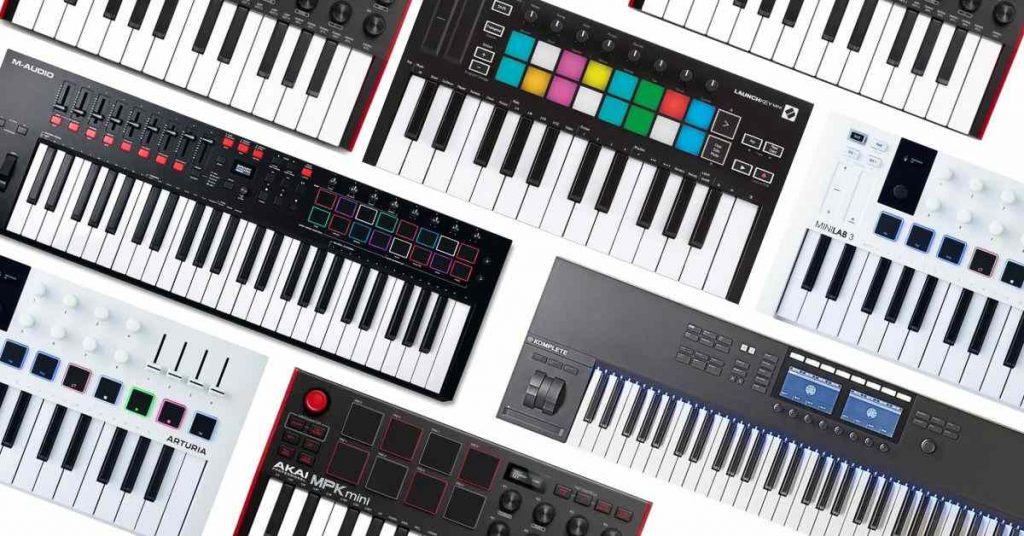
MIDI Keyboard
A MIDI keyboard is a keyboard that you plugin into your computer or other hardware to trigger sounds. If you plugin it into your computer, it will allow you to play virtual instruments within your DAW.
Many different MIDI keyboards are available, with a good amount of them providing additional MIDI controls such as DAW start & stop, assignable knobs and faders, and drum pads.
I recommend beginner producers get a MIDI keyboard as it will help you play melodies, chords, and drum patterns and learn how MIDI controllers can be used to control your DAW. You don’t need to spend the earth, something like the Novation Launch key Mini will do.
You can do more research with my guide to MIDI Keyboards.
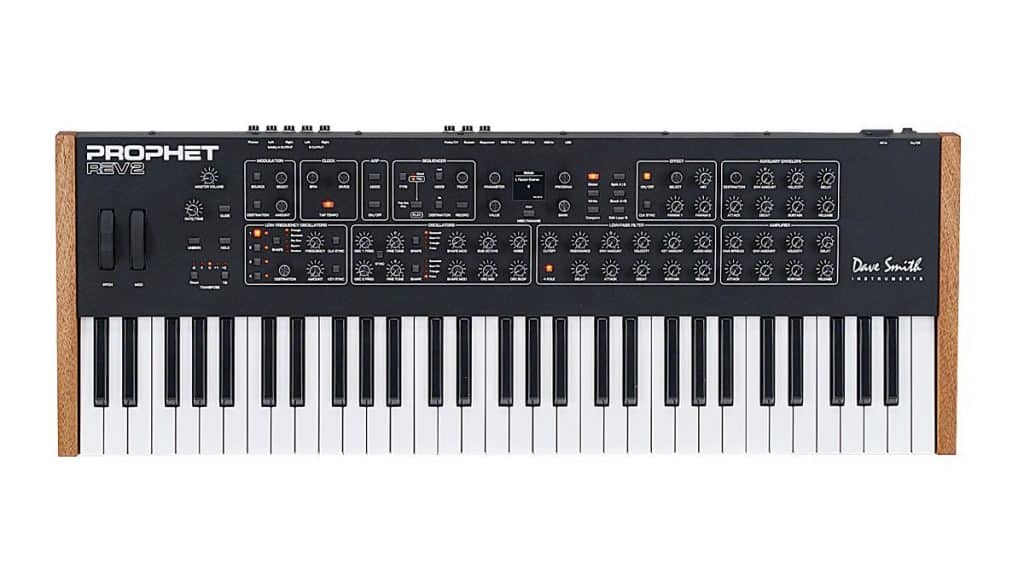
Hardware – Instrument
Synths, drum machines, FX, sequencers, modular synths, groove boxes… There’s a LOT of hardware instruments to choose from. As you just started producing electronic music, I’d wait a while till you purchase your first hardware instrument. Get comfortable with your DAW and the basics of producing electronic music first. As you start to make music, you’ll start to understand what kind of sound you are trying to make. You may then realize that a certain piece of equipment will help you achieve that goal.
Start simple, then add the complexity to your setup as you go.
If you’re making electronic music without a DAW (have already bought hardware), then I’d suggest sticking to one or two items of kit – learning them first, then increasing the complexity of your setup as you need.
If the DAWless setup is something that appeals to you – you could consider an all-in-one piece of hardware like the Digitakt, Analog Four, or Octatrack from Elektron
Hardware – Studio Gear
Along your electronic music production journey, you will gradually need to familiarise yourself with a range of studio gear. Most of the studio gear is emulated in software format and can be learned via your DAW or third-party plugins. Understanding the following bits of gear will help improve your production.
- Compressors
- EQ
- Saturation
- Reverb
- Delay
Plugins
The big plugin companies may not like me saying this… but… you don’t need third-party plugins to make good music. Your DAWs default plugins will be more than good enough to make releasable music. Yes, plugins are great. I have a load, but they won’t automatically make your music productions sound amazing. It’s best to learn the basics with your stock plugins and then expand to third-party ones when you can hear the difference.
Related: Best Plugins for EDM
That being said, there are some things your DAW plugins can’t do – this is where a third party plugin that does that job comes in. Before you spend all your cash – consider that learning your plugins is another skill to acquire. Many plugins emulate old gear, so you will learn how to use software versions of hardware compressors, EQ, FX, Saturators, Limiters etc. So don’t flood yourself with too many to learn.
If you still have a hankering for plugins, have a look at these essential plugins or save yourself some cash with these free VST plugins.
Free Stuff
You don’t need to spend all your hard-earned cash on new gear and new plugins… there is a wealth of free samples, free Ableton packs, and free plugins out there. I make a lot of free Ableton packs which will help you explore sound design, you can browse them here.
I’ve also collated a lot of free plugins and free stuff on this site – so check them out too 🙂
- Free Synth Plugins
- Free Drum Machines
- Free Effect Plugins
- Free Reverb Plugins
- Free Ableton Templates
- 200 Free Ableton Packs
My advice would be to try a few at once so you don’t get overwhelmed 😉 I think it’s much better to spend some time learning a new plugin to get the most out of it.
What Kind of Electronic Music Do You Want to Make?
Electronic music has a lot of subgenres. If you’re unsure which genre to start composing, pick out a genre that inspires and evokes an emotional reaction in you. Tapping into this emotion will help guide your creativity.
If you’re stuck or need some inspiration, do some research by listening to a variety of subgenres on Beatport. See what stands out to you.
Knowing the subgenre of the music you want to make will also help you identify the aesthetic, gear, bpm, and production techniques you’ll need to use.
For example – if you wanted to learn how to make acid techno:
- It’d be useful to get a TB 303, either as hardware or a plugin, as this will help you achieve the acid sound you’re after.
- Tracks are normally around 130bpm
Understanding the genre’s aesthetic, sound design, and production techniques will further help you to re-create the sound of your chosen genre. I can’t cover each subgenre in this article, so I encourage you to research your genre of choice and find out its ‘rules’.
The rules are a guide to the kind of sounds used, arrangement, BPM, and drum patterns.
To do this, try searching Google or YouTube for:
- ” [musical genre of choice] sound design”
- ” [musical genre of choice] gear”
- ” [musical genre of choice] plugins”
- ” [musical genre of choice] production techniques”
- ” [musical genre of choice] drum patterns”
You can also find short electronic music courses that teach you about specific genres and production techniques. You’ll find a decent selection at Loopmaster’s.
Another useful platform is Splice.
You can use Splice to understand the kind of samples, drum patterns and track components of your subgenre. Let’s say you wanted to learn how to make Tech House; you can search Splice for Tech House and listen to some sample packs. Sample packs are broken down into one-shot hits and loops. These samples are often broken down into parts of the track, such as:
- Drum Loops
- Synth
- Tops
- Bass
- FX
- Percussion (Kicks, Hats, Snares, Claps)
Listening to the samples will help to break down the ideas, track components and aesthetics used within your genre. This will then guide your compositions by helping you understand:
- What kind of percussion (kicks, hats, claps) the genre uses.
- What the drum loops sound like on their own
- Patterns for the “Tops” (Hi hat & Snare loops)
- Synth sounds and composition styles
- Low end bass riff
- Sound design aesthetic
Once you’ve got a good idea of what kind of electronic music you want to make, it’s time to start composing…
The Production Workflow
So, where do you begin making the music?? Before we start making music, it’s useful to break down the stages of electronic music production. They are as follows:
Sound design >> Composition >> Arrangement >> Mixing >> Mastering.

Many electronic music producers will start at the sound design stage to create a palette of sounds to use in the composition stage. During the composition stage, they may also introduce new sounds and instruments as the music takes shape. Once the composition is done, they will arrange the track’s structure. The final stage is mixing it to ensure it sounds as good as possible. Once mixing is complete, it will normally be sent off to a third party to be mastered.
This is a linear view of the process. Most often, the sound design, composition, and arrangement stages become interwoven. Even a few small mixing decisions can be made during these stages, too.
However, the final mix and mastering stage will always remain at the end.
Sound Design
Electronic music producers spend a lot of time finding and developing ‘their sound’; this can take years. You’ll notice that the music of your favorite artists sounds similar; this, in part, is due to their attention to sound design and creating their own unique sounds. Used throughout multiple records in provides an identity and cohesion. I encourage you to do the same.
When we spend the time to design our own sounds, we move closer to developing our own style and acoustic aesthetic that people recognize. There are lots of different ways sound design can be done. We could create our own drum samples, and synth presets, or use particular effects processing on our sounds. There is a lot to explore – and this is the fun of learning how to make electronic music, you get to experiment!
You can do sound design sessions in your DAW of choice before sitting down to compose. This involves spending time understanding the effects in your DAW and using them to make lots of weird sounds. As you create your percussion, sounds, and synth presets, save them into your user library so you can compose with them later.
While you’re learning the sound design process, you will also be defining your musical taste. What you decide to keep from your sound design sessions will be informed by what you think sounds cool and what genre of music you are making.
Once you have some sounds that you like, you can start to make some music with them.
Note: If you’re just starting to make electronic music and find Sound design a little overwhelming, just use your stock DAW’s sounds to begin with. You can also use samples from Splice where someone else has done the sound design for you.
Composition
Ok, let me get this out of the way… there is no ‘right’ way to compose music. What I’m writing here is an overview of basic track structure. You can use this foundation to build upon and make your own music. So, remember that this is a guide and not a rule! I encourage you to experiment as much as possible and break these rules if you want. However, to break the rules, it helps to know them…
As a basic rule, most electronic music is comprised of the following elements:
- Kick Drum
- Bass
- Pads
- Synth
- Claps
- Hats
- Percussion
- FX
- (Maybe a vocal)
You will compose each of these elements and then arrange them together into a track.
Where you start your composition is up to you; some people like to start with drums…
Drums and Beats
In the section “What kind of music do you want to make?” we looked at the “rules” of your subgenre. How you sequence your drums is going to be influenced by those ‘rules’. Have a play at composing drum loops similar to your chosen genre – this will be hard at first as it won’t “sound right” compared to released music. That’s OK – it won’t at this stage in the production process, and also because the released music you’re comparing to has been mixed and mastered professionally. For now, focus on composition to get a feel for how the rhythms work and how the percussive elements complement and interact with each other.
Deconstructing the drum patterns will help to train your ears too.
You can research drum patterns for your genre and copy them into your projects. Try playing a pattern with various samples to see how it changes the feel of the groove.
Another method for understanding what a drum loop contains rhythmically is to use Ableton’s drums to MIDI function. To do this, import a drum loop into Ableton, right-click on it, and select “Convert drums to MIDI.” You will then get a MIDI version of the drum loop. This will help you recreate the drum loop. (Note: As great as Ableton is, it doesn’t always provide an exact MIDI replication with complicated patterns.)
Read more on that at the Ableton Site.
If you investigate YouTube, you’ll find plenty of videos explaining how to make beats. You may also benefit from courses that teach you specifically how to make drums for your chosen subgenre. Loopmasters offers a good selection of those.
Another method is to use samples from Splice straight into your projects and then chop them up and manipulate them. Depending on your genre, you can also lift samples of breakbeats from records and use them in your productions.
Bass and basslines
The bass sounds and how you sequence your bass will be influenced by your genre ‘rules’.
Bass is a really important element in electronic music. It adds weight and depth to a track, enhancing the groove and melody. It’s really important that you get your bassline working with your kick so that they feel cohesive and don’t clash. This helps to keep your groove flowing.
You can create complex basslines that add variation, syncopation, and melodic content to your tracks or use a simple sub-bass to reinforce the percussion. Do some research into your genre of choice to get an idea of what kind of bass sounds and basslines are common.
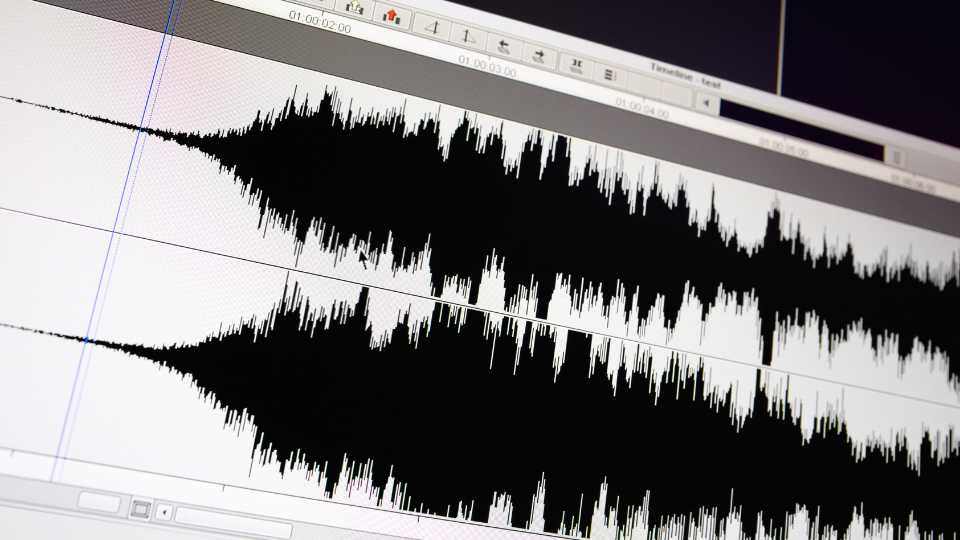
Samples
Samples are included in a LOT of electronic music.
You can use samples from different sources, such as one-shot drum hits, samples from records, commercial loops from companies like Splice, or a sample of a single tone or note mapped across a keyboard, to create a sample-based instrument. (I make many of my free Ableton packs like this.)
Ableton’s stock sampler is great for all these sampling duties – as well as the drum rack for drum beats.
Each genre’s aesthetic or ‘rules’ may dictate the type of drum samples used. Research sample packs on Splice to get a feel for the snares, kicks, and hi-hats used in your genre.
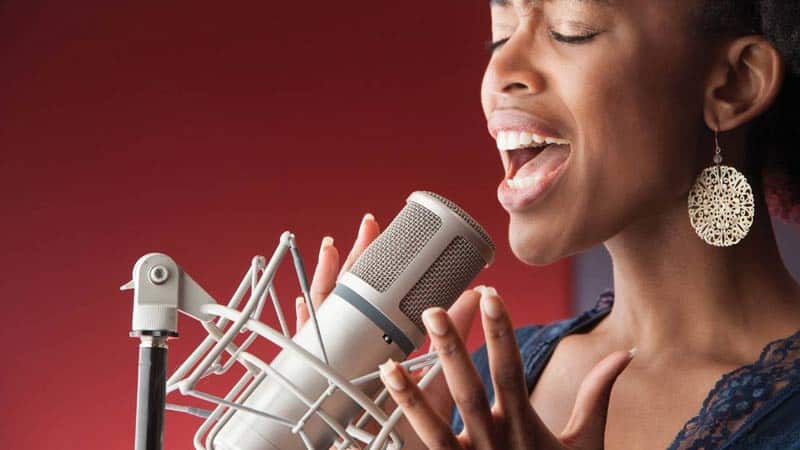
Vocals
You could use your mobile phone to capture lo-fi audio. If you want higher quality, you will need a dedicated microphone and audio device. There are a number of quality microphones available for recording vocals. To get started, the Shure SM58 is a decent, budget-friendly vocal mic.
The microphone plugs into your audio device to record into your digital audio workstation.
In addition to composing great lyrics, there are several vocal recording techniques to learn that will help to improve the quality of your recording. As you start out, try to get as clean a vocal recording as you can and go through the process of comping (compiling your vocal takes) and arranging your recordings into your project. Once this is done, finish the track and mix it too. This will help you understand the whole production process so that you can then refine individual stages in your next track.
You can find vocal samples to use or record yourself or a singer. If you are looking for a professional singer, you can always approach one and ask them to sing on your track. You can find musicians on Soundbetter.
Course of use: Best Music Composition Courses
Music Theory
You don’t need to know music theory to produce electronic music.
Relieved?
It does come in handy though 🙂
I think music theory gets a bad rap. It’s actually really useful and not always complicated. Look at it this way: Music theory is the language of music. It helps to have a little understanding of the basics to help you communicate your ideas, but you don’t need to be fluent.
This language helps us to create, analyze, and interpret music. A lot of it we already intuitively know but perhaps don’t have the words for. As you make your own electronic music you will start to identify areas of music theory that maybe of interest to you. For example, you may start to pay more attention to scales and keys or develop curiosity about polyrhythms or harmonies. Investigate each topic as it presents itself to avoid being overwhelmed by music theory.
A useful book if you want to learn more is Music Theory for Electronic Music. Also check out these YouTube channels:
- Learn music theory in half an hour -Andrew Huang
- Yale Music Theory Course – YouTube
- Dr. B Music Theory – YouTube
- https://www.musictheory.net
- Music Theory for Electronic Music Producers – J Anthony Allen PhD
Arrangement
Once you’ve generated all your musical ideas, it’s time to arrange your instrumentation coherently. This is an often overlooked part of the composition process when producing electronic music, but it’s well worth doing. A good arrangement that selects the right instrumentation will help convey the ideas of the music, maintain clarity, and ensure that sounds that occupy the same frequency spectrum don’t interfere with each other.
It’s useful to know that a good arrangement will make mixing your track much easier. A good arrangement helps to separate parts and clarify the main compositional ideas, providing a solid foundation to achieve an uncluttered mix.

Structure
This is slightly different from ‘Arrangement’ in that rather than structuring the instrumentation, we are structuring the energetic flow of the track. You’ll find most electronic music is structured around 16-bar sections, with changes to the structure normally happening every 8, 16, and 32 bars.
This predictability with the 8-bar grid allows the dancefloor and DJs to keep momentum. Unless you are making electronica (or nonclub music), it’s worth sticking to the rules.
A common way to make electronic songs is to start writing a solid 16-bar loop that contains all your track’s main ideas. You can then expand the loop into a full track. To create a structure from this loop, you can begin with 16 to 32 bars of the stripped loop and introduce elements throughout your track until you reach the solid 16-bar loop. Keep in mind that you want to maintain energy and interest as you structure your track.
TIP – Check out the arrangement and structure of a track you like by importing it into Ableton Live. Whilst listening to the track, add Locator markers when you notice a change in the structure. Open a MIDI track below and note the intro, main parts & breaks. This will help to give you an overview of different approaches to track structure. See pic fig 2.1 above.
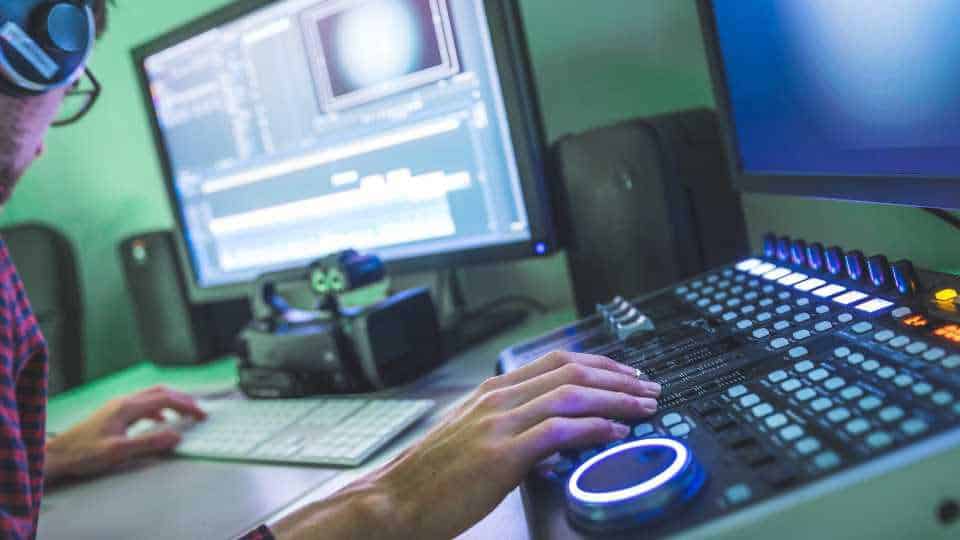
Mixing and Mastering
Mixing
After you’ve finished composing and arranging your track, it’s time to mix it. Being able to mix music is a skill that requires a lot of practice. Be mindful that this will take a long time to learn; so take your time.
Note: To avoid confusion, mixing is the final stage of the production process — not mixing electronic music together like a DJ would.
The main idea behind mixing your music is to improve the quality of your production. This stage in the production process is about enhancing the musical ideas and improving the overall sound quality. This is done using various processing to the individual and bus channels of your production.
When I think of mixing, I consider this simple idea: I want to balance volume, stereo image & frequencies across the whole track.
We can smooth out and control the dynamics with compression and volume automation. Sculpt and balance frequencies with EQ. Balance the stereo field with careful planning and use effects to enhance individual parts and sub-mixes.
When approaching your mix, it is a good idea to ask yourself, “What do I want my mix to do?”. What is the focus of your mix? Knowing where your music will be played and what the main idea and intent of the music is will help you clarify the aim of your mix.
Learning how to mix has to be done through experience, trial and error, and lots of practice. I recommend that you try and finish and mix as many tracks as you can. Your mixing knowledge will build over time as you progress. Find a place to get feedback on your mixes – this can range from forums, Facebook groups, or friends. If you haven’t already built a network of producer friends, I encourage you to do so – getting support and feedback from peers and more experienced electronic music producers will help you improve your production skills. As a starting point, check out your local Meetup.com groups or Ableton User Groups to tap into the scene in your area.
Learn more about mixing here:
- Audio Mixing Bootcamp – Bobby Owinski
- The Mixing Engineers Handbook – Bobby Owinski
- Mixing Secrets for the Small Studio – Sound on Sound (Mike Senior)
- Landr How to Mix
- iZotope Learn Mixing
Mixing Courses:
9 of the Best Mixing and Mastering Courses Online 2024
Mastering
I was always taught that mastering was best left to the professionals. This was partly due to the specialist hardware required when mastering. Another more important factor was the objectivity provided by a third party who hadn’t heard or spent any time with your music. The mastering engineer provided a fresh pair of ears on the final production that could be used to add the finishing touches.
But what is mastering?
It’s the final production process that adds polish to the project.
A mastering engineer will receive your mixdown file and apply appropriate EQ and compression to make your track sound fatter, richer, and louder. They will often also provide you with a master that has been optimized for streaming (and on-request vinyl).
If you are mastering more than a single, the mastering engineer will match the levels of each song on the album and insert spreads (the time between tracks) so that the album or EP plays smoothly.
A mastering engineer will have a studio equipped with exceptional monitoring equipment to hone in on your mix’s problem areas. They will then be able to advise any amendments you need to make.
You don’t have to use a third party; you can do this yourself via online mastering platforms such as Landr, Aria & eMastering. This is a cheap alternative that will give you variable results. If you’re curious, seeing how your music will turn out can be a worthwhile learning experience.
Alternatively, if you want to master yourself, you will need to focus on these areas:
- Remove all glitches & Noise
- Setting your overall level with a limiter
- Adjusting the tonal balance of the track
- Tame dynamics and add colour if required
- Your track holds up when played against others
There are plugins that will “master” your track at the click of a button. In my humble opinion, they will not provide you with a decent master, so take their output with a pinch of salt. However, there are some benefits to using them as a learning tool. Spend time understanding how the suggested settings affect your overall mix.
If you want to learn more about mastering:
- The Izotope website has a lot of useful articles on mastering.
- Mastering Audio: The Art and Science – Bob Katz
Try these Mixing and Mastering courses
Further Learning & Resources
Free Plugins
You don’t have to buy all your plugins – there are a lot of decent free ones out there. Before making any big purchases – check these out:
- Free Synth Plugins
- Free Reverb Plugins
- Free Saturation Plugins
- Free Effect Plugins
- Free Drum Machine Plugins
Free Ableton Packs
I make and give away free Ableton packs. I’ve also compiled a list of over 200+ free Ableton packs that are worth checking out.
Books
The following books will help you improve your mixing skills and teach you how to make electronic music faster. They provide solid detail and easy-to-understand explanations of complex topics.
- The Secrets of Dance Music Production – Attack Magazine
- Mixing Secrets for the Small Studio – Mike Senior
- Dance Music Manual – Rick Snoman
- The Mixing Engineer’s Handbook – Bobby Owsinski
You can find more books on electronic music production here.
Websites & YouTube videos
Useful websites & YouTube channels for producers:
- Your first-hour making electronic music – Oscar at UnderDog Music School -(Ableton Live orientation & Drum programming)
- 18 of the best YouTube Channels for Music Production
- 75 of the Best Music Production Websites, Blogs & Forums
Courses
If you want to take your learning to the next level, enrolling in a part-time course may be worth your while.
The Best Music Production Schools
Ableton Courses
The Best Electronic Music Production Courses
Best Online Audio Engineering Schools
The Best Online Music Business Courses
Best Mixing and Mastering Courses Online 2024
Best Music Composition Courses
